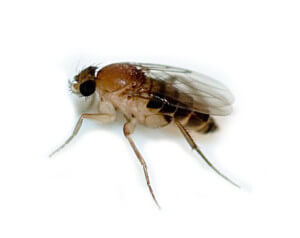
J & L Pest Control is a family owed business that has been practicing Integrated Pest Management (IPM) services since it was founded.
T (631)-605-9919
Email: jandlpestcontrol@gmail.com
J & L Pest Control
1090 Martinstien Ave.
Bay Shore, NY 11706

L
J. L. Caslncr
INTRODUCTION. The common name of small dung comes from the fact that most species are common near manure or decaying vegetation and that they are small flies, less than 1/4" (6 mm) long. These flies are typically nuisance pests, and of very minor medical concern. They are very common throughout the United States and Canada, with about 117 species recorded.
RECOGNITION. Adults about 1/32-3/16" (0.9-5 mm) long, stout-bodied. Color dull, usually black or dark brown, sometimes brown with head or legs yellowish; wings rarely spotted. Head with oral vibrissae (2 bristles, one located to each side of face just above mouthparts); mouthparts thick, fleshy, with palpus small. Antenna appearing 2-segmented (1st of 3 segments very small), 2nd segment lacking longitudinal seam (impressed line), arista preapical. Thorax with mesonotal suture (impressed line across top of mesothorax) incomplete or lacking. Wing with costa (front marginal vein) interrupted/broken 3 times within basal 1/2 of wing, before and just after humeral crossvein (h) and just before R, meets costa; subcostal vein (Sc) incomplete, fading out just beyond humeral crossvein (h). Hing leg with 1st tarsal segment swollen and shorter than 2nd segment.
Mature larvae usually slightly longer than respective adults, slender, narrowed towards front; bottom surface of segments with creeping welts (swollen rough areas); posterior/rear spiracles usually on 2 subcylindrical lobes/stalks, each spiracle with 3 oval or slit-like openings and 3-5 groups of hairs/setae (sometimes branched) to outside.
SIMILAR GROUPS. (1) Small fruit flies (Drosophilidae) with wing costal vein (C; y y thickened front margin) broken 2 times (between where h/humeral crossvein and R,/1st vein meet costa), hind leg with 1st tarsal segment long and slender, much longer than 2nd segment. (2) Humpbacked flies (Phoridae) with humpbacked appearance in side view, wing with strong/dark basal front veins (costal area) and 3-5 weaker (less distinct) unbranched oblique veins, hind femora flattened. (3) Moth/drain/sewage flies (Psychodidae) have body and wing veins densely covered with hairs. (4) Fungus gnats (Mycetophilidae) and darkwinged fungus gnats (Sciaridae) are slender, long-legged, mosquitolike, with elongate coxae, wing costa (front margin) unbroken/uninterrupted, and antenna with many segments and lacking an arista/bristle.
BIOLOGY. Very little is known about the biology of the species in this family. Adults probably copulate shortly after emergence and egg laying begins 5-12 days later. Females lay their eggs usually partly buried in the larval food. Eggs hatch in about 24-48 hours. The 3 larval instars require at least 4-12 days. The duration of the pupal stage is quite variable, requiring 4-18 days or more. The life cycle (egg to egg) for 2 species found in the United States requires 28-34 days for Halidayina spinipennis (Haliday) and 76-205 days for Limosina silvatica (Meigen) under “natural” conditions. Adults may live for 38-62 days, more or less.
Among the species found in North America, Pullimosina pullula (Zetterstedt) is parthenogenetic (egg development without fertilization), Thoracochaeta seticosta (Spuler) has pupal diapause in winter, and Spelobia clunipes (Meigen) is active as an adult during midwinter below snow cover.
Of medical importance is Poecilosomella angulate (Thompson) which has caused intestinal myiasis in humans; this species is found from Texas to Florida, Bermuda, West Indies, Central and South America, and in Hawaii. Many organisms from protozoa to bacteria, including Salmonella spp., Escherichia coii (Migula), Staphylococcus spp., and Bacillus spp., have been found associated with small dung flies.
HABITS. These flies are commonly associated with all kinds of moist decaying organic matter including dung, carrion, fungi, seaweed, refuse, compost, etc. Around structures such materials can be commonly found in the bottoms of garbage and trashcans as well as dumpsters which are not regularly cleaned. Food processing plants, restaurants, and bakeries which clean with high-pressure water hoses can create breeding sites in and under equipment because both water and food get trapped under equipment and in other cracks and crevices when such a cleaning technique is used. Filthy floor drains are potential breeding sites. Moist/damp elevator pits can also be a source. Actually, almost any place where phorid/humpbacked or small fruit flies might be found is a potential small dung fly breeding site.
Around homes, compost piles/pits can be an important source, especially if moist organic kitchen refuse is incorporated/added. Dog excrement which is not routinely cleaned up can also be a source. Leakage from sewer pipes in crawl spaces, etc. is a potential breeding site.
CONTROL. Follow the basic 5 steps of identification, inspection, sanitation, mechanical control/exclusion, and insecticide application if required. The key to control is to find and eliminate the breeding sources. Since there are often several breeding sources, do not stop when the first one is discovered but continue inspection until all potential sites have been examined.
n most cases, it will be the responsibility of the owner or manager of the building or business to clean up or remove the breeding sites. This person must be made to under¬stand the critical role proper sanitation practices play in the elimination and/or prevention of small dung fly infestations.
When cleaning by pressure washing has trapped food under the bottom edges of equip¬ment or its legs, it may be necessary to move or lift the equipment for thorough cleaning. Then completely dry the floor and equipment, followed by the application of a silicone caulk to seal this crack/gap.
Drains should be treated with a microbial formulation, with foam delivery being most effective; bleach and/or hot water are ineffective. After all the breeding sites have been cleaned, an ULV application of a non-residual insecticide may be used to kill the remain¬ing adult flies. The application of residual insecticides is rarely, if ever, necessary.

Mature larvae usually slightly longer than respective adults, slender, narrowed towards front; bottom surface of segments with creeping welts (swollen rough areas); posterior/rear spiracles usually on 2 subcylindrical lobes/stalks, each spiracle with 3 oval or slit-like openings and 3-5 groups of hairs/setae (sometimes branched) to outside.
SIMILAR GROUPS. (1) Small fruit flies (Drosophilidae) with wing costal vein (C; y y thickened front margin) broken 2 times (between where h/humeral crossvein and R,/1st vein meet costa), hind leg with 1st tarsal segment long and slender, much longer than 2nd segment. (2) Humpbacked flies (Phoridae) with humpbacked appearance in side view, wing with strong/dark basal front veins (costal area) and 3-5 weaker (less distinct) unbranched oblique veins, hind femora flattened. (3) Moth/drain/sewage flies (Psychodidae) have body and wing veins densely covered with hairs. (4) Fungus gnats (Mycetophilidae) and darkwinged fungus gnats (Sciaridae) are slender, long-legged, mosquitolike, with elongate coxae, wing costa (front margin) unbroken/uninterrupted, and antenna with many segments and lacking an arista/bristle.
BIOLOGY. Very little is known about the biology of the species in this family. Adults probably copulate shortly after emergence and egg laying begins 5-12 days later. Females lay their eggs usually partly buried in the larval food. Eggs hatch in about 24-48 hours. The 3 larval instars require at least 4-12 days. The duration of the pupal stage is quite variable, requiring 4-18 days or more. The life cycle (egg to egg) for 2 species found in the United States requires 28-34 days for Halidayina spinipennis (Haliday) and 76-205 days for Limosina silvatica (Meigen) under “natural” conditions. Adults may live for 38-62 days, more or less.
Among the species found in North America, Pullimosina pullula (Zetterstedt) is parthenogenetic (egg development without fertilization), Thoracochaeta seticosta (Spuler) has pupal diapause in winter, and Spelobia clunipes (Meigen) is active as an adult during midwinter below snow cover.
Of medical importance is Poecilosomella angulate (Thompson) which has caused intestinal myiasis in humans; this species is found from Texas to Florida, Bermuda, West Indies, Central and South America, and in Hawaii. Many organisms from protozoa to bacteria, including Salmonella spp., Escherichia coii (Migula), Staphylococcus spp., and Bacillus spp., have been found associated with small dung flies.
HABITS. These flies are commonly associated with all kinds of moist decaying organic matter including dung, carrion, fungi, seaweed, refuse, compost, etc. Around structures such materials can be commonly found in the bottoms of garbage and trashcans as well as dumpsters which are not regularly cleaned. Food processing plants, restaurants, and bakeries which clean with high-pressure water hoses can create breeding sites in and under equipment because both water and food get trapped under equipment and in other cracks and crevices when such a cleaning technique is used. Filthy floor drains are potential breeding sites. Moist/damp elevator pits can also be a source. Actually, almost any place where phorid/humpbacked or small fruit flies might be found is a potential small dung fly breeding site.
Around homes, compost piles/pits can be an important source, especially if moist organic kitchen refuse is incorporated/added. Dog excrement which is not routinely cleaned up can also be a source. Leakage from sewer pipes in crawl spaces, etc. is a potential breeding site.
CONTROL. Follow the basic 5 steps of identification, inspection, sanitation, mechanical control/exclusion, and insecticide application if required. The key to control is to find and eliminate the breeding sources. Since there are often several breeding sources, do not stop when the first one is discovered but continue inspection until all potential sites have been examined.
n most cases, it will be the responsibility of the owner or manager of the building or business to clean up or remove the breeding sites. This person must be made to under¬stand the critical role proper sanitation practices play in the elimination and/or prevention of small dung fly infestations.
When cleaning by pressure washing has trapped food under the bottom edges of equip¬ment or its legs, it may be necessary to move or lift the equipment for thorough cleaning. Then completely dry the floor and equipment, followed by the application of a silicone caulk to seal this crack/gap.
Drains should be treated with a microbial formulation, with foam delivery being most effective; bleach and/or hot water are ineffective. After all the breeding sites have been cleaned, an ULV application of a non-residual insecticide may be used to kill the remain¬ing adult flies. The application of residual insecticides is rarely, if ever, necessary.
